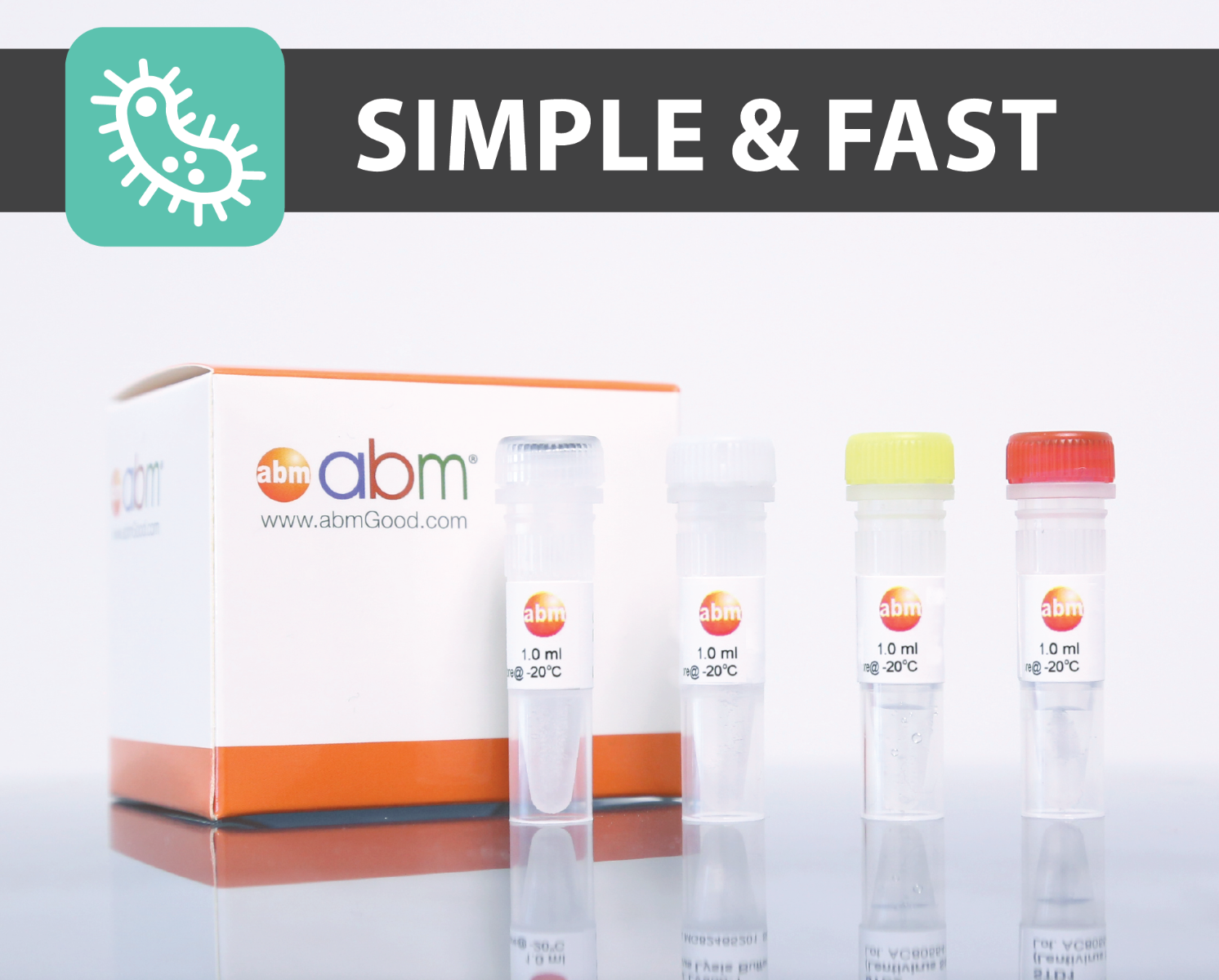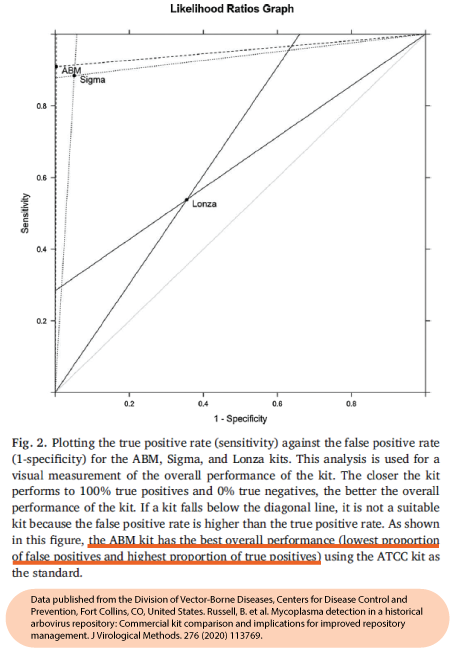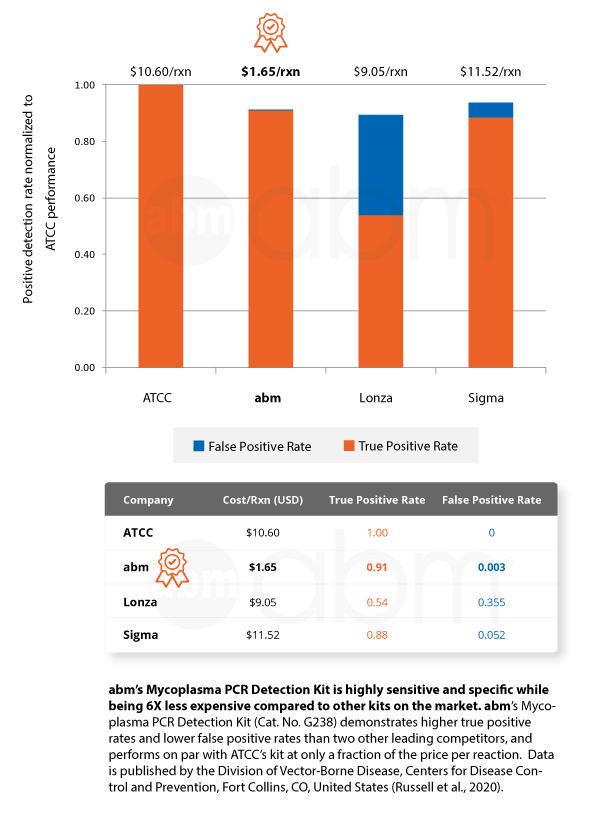Mycoplasma PCR Detection Kit
|
Cat. No.
|
G238
Print
|
|
Name
|
Mycoplasma PCR Detection Kit
|
|
Description
|
 |
Save when you buy abm's Mycoplasma PCR Detection Kit bundled with MycoAway™ Elimination Cocktail (Cat. No. G398). Click here and add this bundle to your cart to save instantly!
|
Enjoy superior performance at lower costs!
abm's Mycoplasma PCR Detection Kit offers highly specific and sensitive detection of 200+ strains of Mycoplasma in less than 2 hours. This bestselling kit is designed to minimize false positives, ensuring quick and reliable routine screening of cell cultures. A recent official publication by a national public health agency found that our kit out-performs Sigma and Lonza's kits while being 6X less expensive than ATCC's kit (Russell et al., 2020).
Mycoplasma species are highly undesirable, easily acquired, and notoriously difficult to detect, altering infected cells at the molecular level and leading to visible changes in cell morphology and growth characteristics. Timely detection of Mycoplasma in cell culture media is recommended in order to deter wide-spread contamination and save on the costly efforts of elimination. Our proprietary MasterMix formulation contains a gel loading dye, making it convenient for gel electrophoresis.
Kit Features:
- No DNA isolation needed: Add cell culture media sample directly to PCR reaction
- Rapid and Comprehensive: Detect 200+ Mycoplasma species in less than 2 hours
- Highly Sensitive and Specific: Demonstrated the highest true positive and lowest false positive rates compared to competing kits
- Easy-to-use: Includes ready-to-use primer mix and positive control
- 6X less expensive per sample compared to competing kits (Russel et al., 2020)
- Out-performs Sigma and Lonza's kits (Russel et al., 2020)
- Combine with our bestselling Mycoplasma Elimination Cocktail (Cat. No. G398) to eliminate 70+ species of Mycoplasma
- Want to cover more species and confidently detect false negative results with an internal PCR control? Try our new Mycoplasma Pro PCR Detection Kit (Cat. No. G239)
| Product Components |
Quantity |
| BlasTaq™ 2X PCR MasterMix |
1.25 ml
|
| Primer Mix |
100 μl
|
| Positive Control |
250 μl
|
| Nuclease-Free H2O |
1.0 ml
|
|
Customer Testimonial
"The mycoplasma detection kit we received from ABM worked very well. It was fast, easy to use, and, with the included controls, the results were very easy to interpret. We will purchase this kit again the next time we are in need of mycoplasma detection."
- Haylie Romero, University of California San Diego
|
|
An official publication by a national public health agency finds our kit out-performs Sigma and Lonza's kits:
Russell, B. J., Horiuchi, K., Velez, J. O., Goodman, C. H., & Johnson, B. W. (2020). Mycoplasma detection in a historical arbovirus repository: Commercial kit comparison and implications for improved repository management. Journal of virological methods, 276, 113769. https://doi.org/10.1016/j.jviromet.2019.113769
|
 |
ISO 13485:2016 MDSAP Certified
Our PCR Products are manufactured under a Quality Management System conforming with ISO 13485:2016 as certified by Intertek (a MDSAP recognized auditing organization).
|
Why test your cells for Mycoplasma?
Due to its small size, Mycoplasma can be present in your growth media without being visibly detected. This can cause significant errors in your experiments due to its effects on:
- proliferation
- metabolism
- gene synthesis & processing
- adhesion properties
- and more
Many publishers now request Mycoplasma testing to be reported along with manuscript submissions to ensure accuracy in data reporting. Visit our learning resources center to read more about Mycoplasma contamination.
|
|
Unit
|
100 rxn
|
|
Storage Condition
|
Store at -20°C. This product is stable for 2 years from the date of shipping if stored and handled properly.
|
|
Material Citation
|
If use of this material results in a scientific publication, please cite the material in the following manner: Applied Biological Materials Inc, Cat. No. G238
|
|
|
Can samples be collected in advance and stored?
|
|
Collected samples can be stored at 4°C for 3-5 days before testing, or -20°C if planning to store for a longer period of time. Please note, samples should be drawn from cells that have been in culture for at least 48-72 hours un-disturbed and are at least 80% confluent.
|
|
|
Gel electrophoresis shows non-specific amplifications. Any suggestions on how to prevent this?
|
|
Non-specific amplifications can be a result of DNA contamination, excessive templates, and/or wrong annealing temperature. This can be prevented by touchdown PCR.
Touchdown PCR:
Lid 105°C
Volume 25 μl
1) 95°C for 3min
2) 95°C for 15s
3) 65°C for 15s
4) 72°C for 15s
5) Go to Step 2, x3
6) 95°C for 15s
7) 60°C for 15s
8) 72°C for 15s
9) Go to Step 6, x3
10) 95°C for 15s
11) 55°C for 15s
12) 72°C for 15s
13) Go to Step 10, x25
14) 72°C for 1min
15) 4°C hold
|
|
|
Will DMSO affect my PCR run?
|
|
As long as the DMSO is diluted and the DMSO content is less than 0.5% in the PCR reaction it should not cause a problem. Too much DMSO would alter the Tm of the primers and thus affect amplification.
|
-
Bahreyni, A., Liu, H., Mohamud, Y., Xue, Y. C., Zhang, J., & Luo, H. (2022). A new miRNA-Modified coxsackievirus B3 inhibits triple negative breast cancer growth with improved safety profile in immunocompetent mice. Cancer Letters, 548, 215849. https://doi.org/10.1016/j.canlet.2022.215849
Conrad, S. J., Silva, R. F., Hearn, C. J., Climans, M., & Dunn, J. R. (2018). Attenuation of Marek's disease virus by codon pair deoptimization of a core gene. Virology, 516, 219-226. https://doi.org/10.1016/j.virol.2018.01.020
Dogra, S., Elayapillai, S. P., Qu, D., Pitts, K., Filatenkov, A., Houchen, C. W., ... & Hannafon, B. N. (2023). Targeting doublecortin-like kinase 1 reveals a novel strategy to circumvent chemoresistance and metastasis in ovarian cancer. Cancer Letters, 578, 216437. https://doi.org/10.1016/j.canlet.2023.216437
Du, L., Liu, W., Aldana-Masangkay, G. et al. SUMOylation inhibition enhances dexamethasone sensitivity in multiple myeloma. J Exp Clin Cancer Res 41, 8 (2022). https://doi.org/10.1186/s13046-021-02226-9
Favaretto, G., Rossi, M.N., Cuollo, L. et al. Neutrophil-activating secretome characterizes palbociclib-induced senescence of breast cancer cells. Cancer Immunol Immunother 73, 113 (2024). https://doi.org/10.1007/s00262-024-03695-5
Jia, B., Yin, X., Wang, Y., Qian, J., He, Y., Yang, C., … Meng, X. (2020). CircRNA-PTN Sponges miR-326 to Promote Proliferation in Hepatocellular Carcinoma. OncoTargets and Therapy, 13, 4893–4903. https://doi.org/10.2147/OTT.S251300
Kalejaiye, T. D., Bhattacharya, R., Burt, M. A., Travieso, T., Okafor, A. E., Mou, X., ... & Musah, S. (2022). SARS-CoV-2 employ BSG/CD147 and ACE2 receptors to directly infect human induced pluripotent stem cell-derived kidney podocytes. Frontiers in Cell and Developmental Biology, 10, 855340. https://doi.org/10.3389/fcell.2022.855340
Kurden-Pekmezci, A., Cakiroglu, E., Eris, S., Mazi, F. A., Coskun-Deniz, O. S., Dalgic, E., ... & Senturk, S. (2023). MALT1 paracaspase is overexpressed in hepatocellular carcinoma and promotes cancer cell survival and growth. Life Sciences, 323, 121690. https://doi.org/10.1016/j.lfs.2023.121690
Lee, M. H., Ratanachan, D., Wang, Z., Hack, J., Adbulrahman, L., Shamlin, N. P., ... & Schaue, D. (2023). Adaptation of the tumor antigen presentation machinery to ionizing radiation. The Journal of Immunology, 211(4), 693-705. https://doi.org/10.4049/jimmunol.2100793
Li, F., Kitajima, S., Kohno, S., Yoshida, A., Tange, S., Sasaki, S., ... & Takahashi, C. (2019). Retinoblastoma inactivation induces a protumoral microenvironment via enhanced CCL2 secretion. Cancer Research, 79(15), 3903-3915. https://doi.org/10.1158/0008-5472.CAN-18-3604
Lorusso, B., Cerasoli, G., Falco, A., Frati, C., Graiani, G., Madeddu, D., ... & Lagrasta, C. (2022). Β-blockers activate autophagy on infantile hemangioma-derived endothelial cells in vitro. Vascular pharmacology, 146, 107110. https://doi.org/10.1016/j.vph.2022.107110
Miranda, L., Mandrich, L., Massa, S., Nutile, T., Crovella, C., De Rosa, I., ... & Caputo, E. (2025). Breast Cancer Tissues and Organoids BioBank: Constitution, Research Activities and Samples Access. Organoids, 4(1), 5. https://doi.org/10.3390/organoids4010005
Nasser, A. M., Melamed, L., Wetzel, E. A., Chang, J. C. C., Nagashima, H., Kitagawa, Y., ... & Miller, J. J. (2024). CDKN2A/B homozygous deletion sensitizes IDH-mutant glioma to CDK4/6 inhibition. Clinical Cancer Research, 30(14), 2996-3005. https://doi.org/10.1158/1078-0432.CCR-24-0562
Pelullo, M., Nardozza, F., Zema, S., Quaranta, R., Nicoletti, C., Besharat, Z. M., ... & Bellavia, D. (2019). Kras/ADAM17-dependent Jag1-ICD reverse signaling sustains colorectal cancer progression and chemoresistance. Cancer research, 79(21), 5575-5586. https://doi.org/10.1158/0008-5472.CAN-19-0145
Pelullo, M., Zema, S., De Carolis, M., Cialfi, S., Giuli, M. V., Palermo, R., ... & Bellavia, D. (2022). 5FU/Oxaliplatin-induced jagged1 cleavage counteracts apoptosis induction in colorectal cancer: A novel mechanism of intrinsic drug resistance. Frontiers in Oncology, 12, 918763. https://doi.org/10.3389/fonc.2022.918763
Roye, Y., Bhattacharya, R., Mou, X., Zhou, Y., Burt, M. A., & Musah, S. (2021). A personalized glomerulus chip engineered from stem cell-derived epithelium and vascular endothelium. Micromachines, 12(8), 967. https://doi.org/10.3390/mi12080967
Zhong, N., Li, D., Wang, B., Kovalchuk, O., & Kovalchuk, I. (2023). Cannabinol inhibits cell growth and triggers cell cycle arrest and apoptosis in cancer cells. Biocatalysis and Agricultural Biotechnology, 48, 102627. https://doi.org/10.1016/j.bcab.2023.102627
Zhou, Q., Pichlmeier, S., Denz, A. M., Schreiner, N., Straub, T., Benitz, S., ... & Regel, I. (2024). Altered histone acetylation patterns in pancreatic cancer cell lines induce subtype‑specific transcriptomic and phenotypical changes. International journal of oncology, 64(3), 1-12. https://doi.org/10.3892/ijo.2024.5614
Zhu, Q., Zhang, X., Lu, F. et al. RUNX1-BMP2 promotes vasculogenic mimicry in laryngeal squamous cell carcinoma via activation of the PI3K-AKT signaling pathway. Cell Commun Signal 22, 227 (2024). https://doi.org/10.1186/s12964-024-01605-x
verified customer
Submitted on: 2023-12-13 21:21:25
The reviewer received points from abmVacations+ Loyalty Program in thanks for sharing their results on the use of this product with the scientific community.
{"id":50500,"cat_no":"G238","retired_cat_no":"","old_cat_no":"G238","name":"Mycoplasma PCR Detection Kit","price":"219.0000","price_before_discount":"0.0000","academic_price":"0.00","commercial_price":"0.00","distributor_price_note":"","unit_quantity":"100 rxn","category_id":249,"category_name":"Mycoplasma Detection","frontend_category_id":123,"frontend_category_ids":"20,28,117,123","gene_id":0,"ncbi_id":0,"gene_name":"","gene_full_name":"","alias":"","accession_number":"","species_id":0,"species":"","real_species_id":0,"cell_type_id":0,"cell_type":"","product_type":"","tissue_id":0,"tissue":"","tissue_system":"","source":"","keywords":"","invisible_search_keywords":"mycoplasma detection kit, mycoplasma test kit, mycoplasma detection, mycoplasma test, mycoplasma, mycoplasma testing, mycoplasma kit,","filter_group_id":13,"filter_group_name":"Cell Lines","filter_name":"Mycoplasma Detection and Elimination","search_filter_ids":"41,51","search_filter_keys":"41-51","temp_field":null,"filter_id":17,"customization":0,"filter_table_id":18084939,"filter_table_name":"","related_group_id":0,"operator":"","status":1,"is_ko":0,"need_remove":0,"units":null,"document_sort":"","price_old":"195.0000","price2024":"219.0000","created_at":null,"updated_at":"2025-03-05 18:04:31","points_rule":7,"Confirmed":"Tony Confirmed","application_no_use":null,"application_id_no_use":null,"raised_in":"","raised_in_id":0,"geo_price_before_discount":"0.00","geo_titer7_price_before_discount":"149.00","cate_url":"mycoplasma-detection.html","frontendBreadcrumbs":[{"id":20,"pid":86,"name":"Cellular Materials","page_id":18,"page_type":"App\\Models\\Category","href":"","sort":20,"show_in_nav":1,"show_in_homepage":1,"has_children":1,"status":1,"related_table":null,"created_at":null,"updated_at":null,"url_key":"cellular-materials.html","url":"cellular-materials.html"},{"id":28,"pid":20,"name":"Microbial Contamination","page_id":222,"page_type":"App\\Models\\Category","href":null,"sort":28,"show_in_nav":1,"show_in_homepage":1,"has_children":1,"status":1,"related_table":null,"created_at":null,"updated_at":"2025-02-10 00:14:28","url_key":"microbial-contamination-control.html","url":"microbial-contamination-control.html"},{"id":117,"pid":28,"name":"Mycoplasma Control","page_id":243,"page_type":"App\\Models\\Category","href":null,"sort":1,"show_in_nav":1,"show_in_homepage":1,"has_children":0,"status":1,"related_table":null,"created_at":"2025-02-05 09:12:27","updated_at":"2025-02-10 00:53:23","url_key":"mycoplasma-contamination-control.html","url":"mycoplasma-contamination-control.html"},{"id":123,"pid":117,"name":"Mycoplasma Detection","page_id":249,"page_type":"App\\Models\\Category","href":null,"sort":0,"show_in_nav":0,"show_in_homepage":0,"has_children":0,"status":1,"related_table":null,"created_at":"2025-02-10 00:51:42","updated_at":"2025-02-10 00:51:42","url_key":"mycoplasma-detection.html","url":"mycoplasma-detection.html"}],"price_flag":0,"builderURL":"","builderViewerURL":"","mapURL":"","viewerURL":"","builderType":"","productType":"App\\Models\\CatalogBaseCells","info_family":"","geo_price":"219.00","geo_price_symbol":"$219.00","category":{"id":249,"categories":"Mycoplasma Detection","pid":243,"url_key":"mycoplasma-detection.html","css":null,"wid":0,"breadcrumbs":null,"breadcrumbsIdJson":"","breadcrumbsHtml":"","description":"\u003Ch2 class=\u0022abm-categories-title-h2\u0022\u003EMycoplasma Detection\u003C\/h2\u003E\n\u003Cdiv\u003E\n\u003Cdiv class=\u0022row\u0022\u003E\n\u003Cdiv class=\u0022col-xs-12 col-sm-12 col-md-8 col-lg-8\u0022\u003E\n\u003Cp\u003E\u003Cstrong\u003Eabm\u003C\/strong\u003E\u0026rsquo;s Mycoplasma detection kits provide fast, reliable, and highly sensitive screening for cell cultures. The \u003Cstrong\u003EMycoplasma PCR Detection Kit\u003C\/strong\u003E detects over 200 Mycoplasma strains in under two hours, with no DNA isolation required. For even broader coverage, the enhanced \u003Cstrong\u003EMycoplasma Pro PCR Detection Kit\u003C\/strong\u003E detects over 300 Mycoplasma and Acholeplasma strains and features an internal control for added accuracy. Both kits outperform competitors in sensitivity, speed, and cost-effectiveness, ensuring the integrity of your cell cultures with ease.\u003C\/p\u003E\n\u003Cdiv class=\u0022row center-div\u0022\u003E\n\u003Cdiv class=\u0022col-xs-12 col-sm-4 col-md-4 col-lg-4\u0022\u003E\u003Cimg src=\u0022\/assets\/images\/catalogPage\/qpcr\/get-results-in-only-2-hours-icon.png\u0022 \/\u003E\n\u003Cp\u003EGet results in 1 hr\u003C\/p\u003E\n\u003C\/div\u003E\n\u003Cdiv class=\u0022col-xs-12 col-sm-4 col-md-4 col-lg-4\u0022\u003E\u003Cimg src=\u0022\/assets\/images\/catalogPage\/qpcr\/detects-200-mycoplasma-species-icon.png\u0022 \/\u003E\n\u003Cp\u003EDetects 200+ Mycoplasma species\u003C\/p\u003E\n\u003C\/div\u003E\n\u003Cdiv class=\u0022col-xs-12 col-sm-4 col-md-4 col-lg-4\u0022\u003E\u003Cimg src=\u0022\/assets\/images\/catalogPage\/qpcr\/easy-to-use-no-dna-isolation-needed-icon.png\u0022 \/\u003E\n\u003Cp\u003EEasy-to-use (no DNA isolation needed)\u003C\/p\u003E\n\u003C\/div\u003E\n\u003C\/div\u003E\n\u003C\/div\u003E\n\u003Cdiv class=\u0022col-xs-12 col-sm-12 col-md-4 col-lg-4\u0022\u003E\u003Cimg style=\u0022width: 100%;\u0022 src=\u0022\/assets\/images\/catalogPage\/qpcr\/mycoplasma-detection-kit-product-image-large.png\u0022 \/\u003E\u003C\/div\u003E\n\u003C\/div\u003E\n\u003Cdiv class=\u0022abm-pt-5\u0022\u003E\n\u003Ch3 class=\u0022abm-custom-page-h1 abm-custom-page-product-name\u0022 style=\u0022margin-bottom: 20px;\u0022\u003E\u003Cb\u003EProduct List\u003C\/b\u003E\u003C\/h3\u003E\n\u003Ctable class=\u0022abm-perfect-table1 bootstrap-table bootstrap-table-hover abm-service-table\u0022 style=\u0022--first-child-width: 55%;\u0022\u003E\n\u003Cthead\u003E\n\u003Ctr\u003E\n\u003Cth\u003EProduct Name\u003C\/th\u003E\n\u003Cth\u003ECat. No.\u003C\/th\u003E\n\u003Cth\u003ESize\u003C\/th\u003E\n\u003Cth\u003EPrice\u003C\/th\u003E\n\u003C\/tr\u003E\n\u003C\/thead\u003E\n\u003Ctbody\u003E\n\u003Ctr\u003E\n\u003Ctd\u003E\u003Ca class=\u0022orange-link\u0022 href=\u0022\/pcr-mycoplasma-detection-kit-g238.html\u0022\u003EMycoplasma PCR Detection Kit\u003C\/a\u003E\u003C\/td\u003E\n\u003Ctd\u003E\u003Ca class=\u0022orange-link\u0022 href=\u0022\/pcr-mycoplasma-detection-kit-g238.html\u0022\u003EG238\u003C\/a\u003E\u003C\/td\u003E\n\u003Ctd\u003E100rxn\u003C\/td\u003E\n\u003Ctd class=\u0022product-price\u0022 data-product=\u0022G238\u0022\u003EInquiry\u003C\/td\u003E\n\u003C\/tr\u003E\n\u003Ctr\u003E\n\u003Ctd\u003E\u003Ca class=\u0022orange-link\u0022 href=\u0022\/Mycoplasma-Pro-PCR-Detection-Kit.html\u0022\u003EMycoplasma Pro PCR Detection Kit\u003C\/a\u003E\u003C\/td\u003E\n\u003Ctd\u003E\u003Ca class=\u0022orange-link\u0022 href=\u0022\/Mycoplasma-Pro-PCR-Detection-Kit.html\u0022\u003EG239\u003C\/a\u003E\u003C\/td\u003E\n\u003Ctd\u003E100rxn\u003C\/td\u003E\n\u003Ctd class=\u0022product-price\u0022 data-product=\u0022G239\u0022\u003EInquiry\u003C\/td\u003E\n\u003C\/tr\u003E\n\u003Ctr\u003E\n\u003Ctd\u003E\u003Ca class=\u0022orange-link\u0022 href=\u0022\/pcr-mycoplasma-detection-elimination-combo-kit-g238-g398.html\u0022\u003EMycoplasma PCR Detection \u0026amp; Elimination Bundle\u003C\/a\u003E\u003C\/td\u003E\n\u003Ctd\u003E\u003Ca class=\u0022orange-link\u0022 href=\u0022\/pcr-mycoplasma-detection-elimination-combo-kit-g238-g398.html\u0022\u003EG238-G398\u003C\/a\u003E\u003C\/td\u003E\n\u003Ctd\u003EBundle\u003C\/td\u003E\n\u003Ctd class=\u0022product-price\u0022 data-product=\u0022G238-G398\u0022\u003EInquiry\u003C\/td\u003E\n\u003C\/tr\u003E\n\u003Ctr\u003E\n\u003Ctd\u003E\u003Ca class=\u0022orange-link\u0022 href=\u0022\/Mycoplasma-Pro-PCR-Detection-Elimination-Kit.html\u0022\u003EMycoplasma Pro PCR Detection \u0026amp; Elimination Bundle\u003C\/a\u003E\u003C\/td\u003E\n\u003Ctd\u003E\u003Ca class=\u0022orange-link\u0022 href=\u0022\/Mycoplasma-Pro-PCR-Detection-Elimination-Kit.html\u0022\u003EG239-G398\u003C\/a\u003E\u003C\/td\u003E\n\u003Ctd\u003EBundle\u003C\/td\u003E\n\u003Ctd class=\u0022product-price\u0022 data-product=\u0022G239-G398\u0022\u003EInquiry\u003C\/td\u003E\n\u003C\/tr\u003E\n\u003C\/tbody\u003E\n\u003C\/table\u003E\n\u003C\/div\u003E\n\u003Cdiv\u003E\n\u003Ch3 class=\u0022abm-custom-page-h1 abm-custom-page-product-name\u0022 style=\u0022margin-bottom: 20px;\u0022\u003E\u003Cb\u003ESensitive Detection\u003C\/b\u003E\u003C\/h3\u003E\n\u003Cdiv class=\u0022row\u0022\u003E\n\u003Cdiv class=\u0022col-xs-12 col-sm-6 col-md-6 col-lg-6\u0022\u003E\u003Cimg style=\u0022width: 100%;\u0022 src=\u0022\/assets\/images\/catalogPage\/qpcr\/mycoplasma-detection-kit-data-1.png\u0022 \/\u003E\u003C\/div\u003E\n\u003Cdiv class=\u0022col-xs-12 col-sm-6 col-md-6 col-lg-6\u0022\u003E\n\u003Cp\u003E\u003Cstrong\u003Eabm\u0027s Mycoplasma PCR Detection Kit can detect samples containing as low as 10 genome copies of Mycoplasma. abm\u003C\/strong\u003E\u0027s Mycoplasma PCR Detection Kit (Cat. No. G238) was used to detect samples containing ~10 to 100,000 genome copies of Mycoplasma. Presence of Mycoplasma was confirmed as a 450 bp band.\u003C\/p\u003E\n\u003C\/div\u003E\n\u003C\/div\u003E\n\u003C\/div\u003E\n\u003Cdiv class=\u0022abm-pt-5\u0022\u003E\n\u003Ch3 class=\u0022abm-custom-page-h1 abm-custom-page-product-name\u0022 style=\u0022margin-bottom: 20px;\u0022\u003E\u003Cb\u003EConfident Results\u003C\/b\u003E\u003C\/h3\u003E\n\u003Cdiv class=\u0022row\u0022\u003E\n\u003Cdiv class=\u0022col-xs-12 col-sm-6 col-md-6 col-lg-6\u0022\u003E\n\u003Cp\u003E\u003Cstrong\u003EMycoplasma Pro PCR Detection Kit (Cat. No. G239) was used to confirm the presence of contamination in five cell culture samples.\u003C\/strong\u003E Positive mycoplasma bands (300 bp \u0026ndash; 600 bp) were detected in samples 2, 3, and 4. Internal PCR control band (180 bp) is present in all lanes which confidently determines a genuine negative result.\u003C\/p\u003E\n\u003C\/div\u003E\n\u003Cdiv class=\u0022col-xs-12 col-sm-6 col-md-6 col-lg-6\u0022\u003E\u003Cimg style=\u0022width: 100%;\u0022 src=\u0022\/assets\/images\/catalogPage\/qpcr\/mycoplasma-pro-figure.png\u0022 \/\u003E\u003C\/div\u003E\n\u003C\/div\u003E\n\u003C\/div\u003E\n\u003C\/div\u003E\n\u003Cp\u003E\n\u003Cscript\u003E\n const catNoList = [];\n document.querySelectorAll(\u0027.product-price\u0027).forEach(el =\u003E {\n if (el.dataset.product) {\n el.innerHTML = \u0027Inquiry\u0027;\n if (el.dataset.type) {\n catNoList.push({\n type: el.dataset.type,\n value: el.dataset.product,\n });\n } else {\n catNoList.push(el.dataset.product);\n }\n }\n });\n fetch(\u0027\/product\/geoPrice\u0027, {\n method: \u0027post\u0027,\n body: JSON.stringify({\n cat_no: catNoList,\n _token: document.querySelector(\u0027meta[name=\u0022X-CSRF-TOKEN\u0022]\u0027).content,\n type: \u0027cells\u0027\n }),\n headers: {\n \u0027Content-Type\u0027: \u0027application\/json\u0027,\n }\n }).then(res =\u003E {\n const json = res.json();\n json.then(response =\u003E {\n if (response.code === 0) {\n const result = response.result;\n for (const key in result) {\n document.querySelectorAll(\u0027.product-price[data-product=\u0022\u0027 + key + \u0027\u0022]\u0027).forEach(el =\u003E {\n el.innerHTML = \u0027$\u0027 + result[key];\n });\n }\n }\n });\n });\n\u003C\/script\u003E\n\u003C\/p\u003E","meta_title":"Mycoplasma Detection","meta_keywords":"Mycoplasma Detection","meta_description":"Mycoplasma Detection","deleted_at":null,"enable":"Y","parent_list":"18,222,243","table_name":null,"image":null,"independentPage":0,"top_type":0,"sort_order":null,"in_footer":0,"fid":null,"created_at":"2025-02-10 00:46:10","updated_at":"2025-04-02 01:04:45"},"info":{"id":4408,"cat_no_base":"G238","parent_id":50500,"image":"no_selection","price-original":null,"description":"\u003Ctable style=\u0022border-collapse: collapse; background-color: #f9eae4; border-radius: 10px; vertical-align: middle; margin-bottom: 20px;\u0022 border=\u00220\u0022 cellpadding=\u002210\u0022\u003E\n\u003Ctbody\u003E\n\u003Ctr valign=\u0022middle\u0022\u003E\n\u003Ctd\u003E\u003Cimg src=\u0022\/assets\/images\/wysiwyg\/promotion-tag-v2.png\u0022 \/\u003E\u003C\/td\u003E\n\u003Ctd\u003E\n\u003Cp\u003E\u003Cstrong\u003ESave\u003C\/strong\u003E when you buy \u003Cstrong\u003Eabm\u003C\/strong\u003E\u0027s \u003Cstrong\u003EMycoplasma PCR Detection Kit\u003C\/strong\u003E bundled\u0026nbsp;with \u003Cstrong\u003EMycoAway\u0026trade; Elimination Cocktail\u003C\/strong\u003E\u0026nbsp;(\u003Ca class=\u0022orange-link\u0022 href=\u0022\/mycoplasma-elimination-cocktail-g398.html#G398\u0022 target=\u0022_blank\u0022 rel=\u0022noopener\u0022\u003ECat. No. G398\u003C\/a\u003E). Click \u003Cstrong\u003E\u003Ca href=\u0022\/pcr-mycoplasma-detection-elimination-combo-kit-g238-g398.html\u0022\u003Ehere\u003C\/a\u003E\u003C\/strong\u003E and add this bundle to your cart to save instantly!\u003C\/p\u003E\n\u003C\/td\u003E\n\u003C\/tr\u003E\n\u003C\/tbody\u003E\n\u003C\/table\u003E\n\u003Cp\u003E\u003Cstrong\u003EEnjoy superior performance at lower costs!\u003C\/strong\u003E\u003C\/p\u003E\n\u003Cp\u003E\u003Cstrong\u003Eabm\u003C\/strong\u003E\u0027s\u0026nbsp;\u003Cstrong\u003EMycoplasma PCR Detection Kit\u003C\/strong\u003E\u0026nbsp;offers \u003Cstrong\u003Ehighly specific and sensitive detection \u003C\/strong\u003Eof\u003Cstrong\u003E\u0026nbsp;\u003C\/strong\u003E200+ strains of Mycoplasma in less than 2 hours. This bestselling kit is designed to minimize false positives, ensuring quick and reliable routine screening of cell cultures. \u003Cstrong\u003EA recent official publication by a national public health agency found that our kit out-performs Sigma and Lonza\u0027s kits while being 6X less expensive than ATCC\u0027s kit\u0026nbsp;\u003C\/strong\u003E\u003Ca class=\u0022orange-link\u0022 href=\u0022https:\/\/doi.org\/10.1016\/j.jviromet.2019.113769\u0022 target=\u0022_blank\u0022 rel=\u0022noopener\u0022\u003E(Russell \u003Cem\u003Eet al.\u003C\/em\u003E, 2020)\u003C\/a\u003E.\u003C\/p\u003E\n\u003Cp\u003EMycoplasma species are highly undesirable, easily acquired, and notoriously difficult to detect, altering infected cells at the molecular level and leading to visible changes in cell morphology and growth characteristics. Timely detection of Mycoplasma in cell culture media is recommended in order to deter wide-spread contamination and save on the costly efforts of elimination. Our proprietary MasterMix formulation contains a gel loading dye, making it convenient for gel electrophoresis.\u003C\/p\u003E\n\u003Cp\u003E\u003Cstrong\u003EKit Features:\u003C\/strong\u003E\u003C\/p\u003E\n\u003Cul\u003E\n\u003Cli\u003E\u003Cstrong\u003ENo DNA isolation needed:\u003C\/strong\u003E Add cell culture media sample directly to PCR reaction\u003C\/li\u003E\n\u003Cli\u003E\u003Cstrong\u003ERapid and Comprehensive:\u003C\/strong\u003E\u0026nbsp;Detect 200+\u0026nbsp;Mycoplasma\u0026nbsp;species in less than 2 hours\u003C\/li\u003E\n\u003Cli\u003E\u003Cstrong\u003EHighly Sensitive and Specific:\u003C\/strong\u003E Demonstrated the highest true positive and lowest false positive rates compared to competing kits\u003C\/li\u003E\n\u003Cli\u003E\u003Cstrong\u003EEasy-to-use:\u003C\/strong\u003E\u0026nbsp;Includes ready-to-use primer mix and positive control\u003C\/li\u003E\n\u003Cli\u003E\u003Cstrong\u003E6X less expensive per sample\u003C\/strong\u003E compared to competing kits\u0026nbsp;\u003Ca class=\u0022orange-link\u0022 href=\u0022https:\/\/doi.org\/10.1016\/j.jviromet.2019.113769\u0022 target=\u0022_blank\u0022 rel=\u0022noopener\u0022\u003E(Russel\u0026nbsp;\u003Cem\u003Eet al.\u003C\/em\u003E, 2020)\u003C\/a\u003E\u003C\/li\u003E\n\u003Cli\u003E\u003Cstrong\u003EOut-performs\u003C\/strong\u003E Sigma and Lonza\u0027s kits\u0026nbsp;\u003Ca class=\u0022orange-link\u0022 href=\u0022https:\/\/doi.org\/10.1016\/j.jviromet.2019.113769\u0022 target=\u0022_blank\u0022 rel=\u0022noopener\u0022\u003E(Russel\u0026nbsp;\u003Cem\u003Eet al.\u003C\/em\u003E, 2020)\u003C\/a\u003E\u003C\/li\u003E\n\u003Cli\u003ECombine with our bestselling \u003Cstrong\u003EMycoplasma Elimination Cocktail \u003C\/strong\u003E(\u003Ca class=\u0022orange-link\u0022 href=\u0022\/mycoplasma-elimination-cocktail-g398.html#elimination\u0022\u003ECat. No. G398\u003C\/a\u003E) to eliminate 70+ species of Mycoplasma\u003C\/li\u003E\n\u003Cli\u003EWant to cover more species and confidently detect false negative results with an internal PCR control? Try our new \u003Cstrong\u003EMycoplasma Pro PCR Detection Kit\u003C\/strong\u003E (\u003Ca href=\u0022\/Mycoplasma-Pro-PCR-Detection-Kit.html\u0022\u003ECat. No. G239\u003C\/a\u003E)\u003C\/li\u003E\n\u003C\/ul\u003E\n\u003Ctable class=\u0022bootstrap-table bootstrap-table-hover abm-service-table abm-perfect-table2\u0022 style=\u0022margin: 20px 0;\u0022\u003E\n\u003Cthead\u003E\n\u003Ctr\u003E\n\u003Cth\u003E\u003Cstrong\u003EProduct Components\u003C\/strong\u003E\u003C\/th\u003E\n\u003Cth\u003E\u003Cstrong\u003EQuantity\u003C\/strong\u003E\u003C\/th\u003E\n\u003C\/tr\u003E\n\u003C\/thead\u003E\n\u003Ctfoot\u003E\n\u003Ctr\u003E\n\u003Ctd\u003EBlasTaq\u0026trade; 2X PCR MasterMix\u003C\/td\u003E\n\u003Ctd\u003E\n\u003Cdiv\u003E1.25 ml\u003C\/div\u003E\n\u003C\/td\u003E\n\u003C\/tr\u003E\n\u003Ctr\u003E\n\u003Ctd\u003EPrimer Mix\u003C\/td\u003E\n\u003Ctd\u003E\n\u003Cdiv\u003E100\u0026nbsp;\u0026mu;l\u003C\/div\u003E\n\u003C\/td\u003E\n\u003C\/tr\u003E\n\u003Ctr\u003E\n\u003Ctd\u003EPositive Control\u003C\/td\u003E\n\u003Ctd\u003E\n\u003Cdiv\u003E250 \u0026mu;l\u003C\/div\u003E\n\u003C\/td\u003E\n\u003C\/tr\u003E\n\u003Ctr\u003E\n\u003Ctd\u003ENuclease-Free H\u003Csub\u003E2\u003C\/sub\u003EO\u003C\/td\u003E\n\u003Ctd\u003E\n\u003Cdiv\u003E1.0 ml\u003C\/div\u003E\n\u003C\/td\u003E\n\u003C\/tr\u003E\n\u003C\/tfoot\u003E\n\u003C\/table\u003E\n\u003Ctable style=\u0022border-collapse: collapse; background-color: #d6effa; border-radius: 10px; vertical-align: middle; margin-bottom: 20px;\u0022 border=\u00220\u0022\u003E\n\u003Ctbody\u003E\n\u003Ctr valign=\u0022middle\u0022\u003E\n\u003Ctd style=\u0022padding: 30px;\u0022\u003E\n\u003Cp\u003E\u003Cstrong\u003ECustomer Testimonial\u003C\/strong\u003E\u003C\/p\u003E\n\u003Cp\u003E\u0022The mycoplasma detection kit we received from ABM worked very well. It was fast, easy to use, and, with the included controls, the results were very easy to interpret. We will purchase this kit again the next time we are in need of mycoplasma detection.\u0022\u003C\/p\u003E\n\u003Cp\u003E- Haylie Romero, University of California San Diego\u003C\/p\u003E\n\u003C\/td\u003E\n\u003C\/tr\u003E\n\u003C\/tbody\u003E\n\u003C\/table\u003E\n\u003Ctable style=\u0022border-collapse: collapse; background-color: #f9eae4; border-radius: 10px; vertical-align: middle; margin-bottom: 20px;\u0022 border=\u00220\u0022\u003E\n\u003Ctbody\u003E\n\u003Ctr valign=\u0022middle\u0022\u003E\n\u003Ctd style=\u0022padding: 30px;\u0022\u003E\n\u003Cp\u003E\u003Cstrong\u003EAn official publication by a national public health agency finds our kit out-performs Sigma and Lonza\u0027s kits:\u003C\/strong\u003E\u003C\/p\u003E\n\u003Cp\u003ERussell, B. J., Horiuchi, K., Velez, J. O., Goodman, C. H., \u0026 Johnson, B. W. (2020). Mycoplasma detection in a historical arbovirus repository: Commercial kit comparison and implications for improved repository management. Journal of virological methods, 276, 113769. \u003Ca class=\u0022orange-link\u0022 href=\u0022https:\/\/doi.org\/10.1016\/j.jviromet.2019.113769\u0022 target=\u0022_blank\u0022 rel=\u0022noopener\u0022\u003Ehttps:\/\/doi.org\/10.1016\/j.jviromet.2019.113769 \u003C\/a\u003E\u003C\/p\u003E\n\u003C\/td\u003E\n\u003C\/tr\u003E\n\u003C\/tbody\u003E\n\u003C\/table\u003E\n\u003Ctable style=\u0022border-collapse: collapse; background-color: #f4f4f4; border-radius: 10px; text-align: center; width: 100%; margin-bottom: 20px;\u0022 border=\u00220\u0022 cellpadding=\u002210\u0022\u003E\n\u003Ctbody\u003E\n\u003Ctr style=\u0022vertical-align: middle;\u0022\u003E\n\u003Ctd style=\u0022text-align: left; vertical-align: middle;\u0022 width=\u002215%\u0022\u003E\u003Cimg src=\u0022\/assets\/images\/wysiwyg\/ISO-Logo-v1.png\u0022 alt=\u0022ISO 13485:2016 MDSAP Certified\u0022 width=\u002285%\u0022 \/\u003E\u003C\/td\u003E\n\u003Ctd style=\u0022padding: 20px 20px 20px 0; text-align: left; vertical-align: middle;\u0022\u003E\n\u003Cp\u003E\u003Cstrong\u003EISO 13485:2016 MDSAP Certified\u003C\/strong\u003E\u003Cbr \/\u003EOur PCR Products are manufactured under a Quality Management System conforming with ISO 13485:2016 as certified by Intertek (a MDSAP recognized auditing organization).\u003C\/p\u003E\n\u003C\/td\u003E\n\u003C\/tr\u003E\n\u003C\/tbody\u003E\n\u003C\/table\u003E\n\u003Cp\u003E\u003Cstrong\u003EWhy test your cells for Mycoplasma?\u003C\/strong\u003E\u003C\/p\u003E\n\u003Cp\u003EDue to its small size, Mycoplasma can be present in your growth media without being visibly detected. This can cause significant errors in your experiments due to its effects on:\u003C\/p\u003E\n\u003Cul\u003E\n\u003Cli\u003Eproliferation\u003C\/li\u003E\n\u003Cli\u003Emetabolism\u003C\/li\u003E\n\u003Cli\u003Egene synthesis \u0026 processing\u003C\/li\u003E\n\u003Cli\u003Eadhesion properties\u003C\/li\u003E\n\u003Cli\u003Eand more\u003C\/li\u003E\n\u003C\/ul\u003E\n\u003Cp\u003EMany publishers now request Mycoplasma testing to be reported along with manuscript submissions to ensure accuracy in data reporting. \u003Ca class=\u0022orange-link\u0022 href=\u0022https:\/\/info.abmgood.com\/cell-culture-quality-control-contamination\u0022 target=\u0022_blank\u0022 rel=\u0022noopener\u0022\u003EVisit our learning resources center\u003C\/a\u003E to read more about Mycoplasma contamination.\u003C\/p\u003E","shipment_type":0,"internal_leadtime":"0","lysate_type":null,"small_image":"no_selection","growth_factor_size":null,"gene_name_no_use":null,"mammalian_selection_marker":null,"mammalian_selection_text":null,"storage_condition":"\u003Cp align=\u0022left\u0022\u003EStore at -20\u00b0C.\u00a0This product is stable for 2 years from the date of shipping if stored and handled properly.\u00a0\u003C\/p\u003E","str_profiles":null,"species_description":null,"cost":null,"note":null,"family":null,"overexpressed_gene":null,"diameter":null,"appearance":null,"pluripotency":null,"recommended_medium_volume":null,"medium":null,"alias":null,"tier_price":null,"operator_no_use":null,"addtime":null,"cell_line":null,"price_type":"Male","gallery":null,"cell_growth_area":null,"cell_morphology":null,"expression_system_type":null,"gene_symbol":null,"insert_size":null,"msrp":null,"msrp_display_actual_price_type":null,"cell_morphology_specification":null,"tax_class_id":2,"inventory_location":"PCR-1B","vector":null,"internal_note":null,"component":null,"quantity_and_stock_status":null,"vector_url":null,"application":null,"minimal_price":null,"seeding_density":null,"seeding_density_cm":null,"seeding_density_ml":null,"source":null,"source_catno":"srcCatNo","osmolarity":null,"weight":null,"royalty_rates":null,"population_doubling_time":null,"source_price":null,"weight_type":"Male","ph":null,"licensor_commission_rate":null,"supplier":"ABM","donor_gender":null,"appearance_general":null,"sterility":"\u003Cp align=\u0022left\u0022\u003EStore at -20\u00b0C.\u00a0This product is stable for 2 years from the date of shipping if stored and handled properly.\u00a0\u003C\/p\u003E","molecular_weight":null,"endotoxin_level":null,"donor_age":null,"news_from_date":null,"news_to_date":null,"expression_system_general":null,"donor_disease":null,"purity":null,"country_of_manufacture":null,"donor_ethnicity":null,"image_label":null,"biological_activity_text":null,"cart2quote_quotable":"2","biosafety":null,"product_quote":0,"small_image_label":null,"immortalization_method":null,"bioactivity_data":null,"formulation":null,"thumbnail_label":null,"mammalian_selection":null,"isolation_method":null,"function":null,"reconstitution":null,"growth_properties":null,"expression_profile":null,"storage":null,"propagation_method":null,"usage":null,"freeze_thaw_recovery":null,"str_profile":null,"str_markers":"","subculture_protocol":null,"preservation_protocol":null,"passage_number":null,"qc":null,"shipping_conditions":null,"disclaimer_general":null,"caution":null,"transfection_reagents_type":null,"licensed_by":null,"licensed_from":null,"licensing_institution":null,"guarantee":null,"depositor":null,"licensor_name":null,"licensor_contact_information":null,"contract_termination_date":null,"links_purchased_separately":null,"samples_title":null,"links_title":null,"links_exist":null,"internal_supplier":"ABM","internal_product_note":null,"donor_history":null,"split_ratio":null,"expression":null,"growth_conditions":null,"recommend":null,"references":null,"cryopreservation":null,"unpacking_storage_instructions":null,"promotions":null,"sync_images":null,"thawing_protocol":null,"type_online":null,"parental_cell_line":null,"mutation_and_validations":null,"knockout_method":null,"clone_no":null,"created_at":"2022-09-07 08:13:18","updated_at":"2025-03-05 18:04:31","concentration":null},"seo":{"id":66110,"catalog_id":50500,"catalog_type":"App\\Models\\CatalogBaseCells","url_key":"pcr-mycoplasma-detection-kit-g238.html","meta_title":"Mycoplasma PCR Detection Kit | abm","meta_keywords":"Mycoplasma PCR Detection Kit, Mycoplasma Detection in Cell Culture","meta_description":"Detect over 200 strains of Mycoplasma in less than 2 hours with our Mycoplasma PCR Detection Kit. This kit offers high sensitivity, specificity, and convenience to help find underlaying mycoplasma infections in cell cultures.","created_at":"2022-09-23 06:53:13","updated_at":"2024-08-23 23:13:15"},"maps":[],"media":[{"id":379592,"parent_id":50500,"parent_type":"App\\Models\\CatalogBaseCells","file_path":"\/m\/y\/mycoplasma-detection-kit-product-image.png","title":null,"text":null,"file_type":"image","alt":null,"url":null,"position":1,"status":0,"entity_id_m2":18084939,"sku_in_m2":"G238","value_id_m2":49912279,"attribute_id":90,"created_at":"2022-07-19 04:36:22","updated_at":"2023-12-22 22:47:12"},{"id":379596,"parent_id":50500,"parent_type":"App\\Models\\CatalogBaseCells","file_path":"\/m\/y\/mycoplasma-detection-kit-workflow.png","title":null,"text":null,"file_type":"image","alt":null,"url":null,"position":2,"status":0,"entity_id_m2":18084939,"sku_in_m2":"G238","value_id_m2":49912280,"attribute_id":90,"created_at":"2022-07-19 04:36:22","updated_at":"2023-12-22 22:47:12"},{"id":379594,"parent_id":50500,"parent_type":"App\\Models\\CatalogBaseCells","file_path":"\/r\/u\/russell-2020-jvirology-fig2.png","title":null,"text":null,"file_type":"image","alt":null,"url":null,"position":3,"status":0,"entity_id_m2":18084939,"sku_in_m2":"G238","value_id_m2":49912292,"attribute_id":90,"created_at":"2022-07-19 04:36:22","updated_at":"2023-12-22 22:47:12"},{"id":379593,"parent_id":50500,"parent_type":"App\\Models\\CatalogBaseCells","file_path":"\/g\/2\/g238-cdc-paper_data-v2.png","title":null,"text":null,"file_type":"image","alt":null,"url":null,"position":4,"status":0,"entity_id_m2":18084939,"sku_in_m2":"G238","value_id_m2":49912291,"attribute_id":90,"created_at":"2022-07-19 04:36:22","updated_at":"2023-12-22 22:47:12"}],"gene":null}






